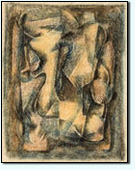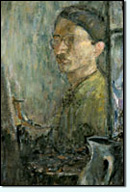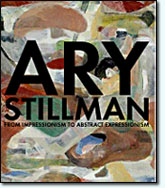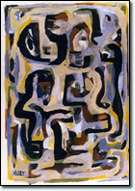Press, The Paintings of Ary Stillman
December 1928
Chicago Tribune (Paris Edition)
by B. J. Kospoth
American Painters, it is bare justice to remark, have not been habitually pampered on this page. With few exceptions, this series of appreciations of contemporary artists has been limited—et pour cause, as they say in France--: to French painters. No one in the world is more firmly convinced than the writer that a great future is dawning in America for art, and all pessimistic statements to the contrary made to him by American artists are impotent to shatter his belief. But the fact remains that, at any rate for the present, American painting appears to the critic as an art of imitation, a constant, visible manifestation of the supremacy of Europe, and particularly of France and Paris, over the New World in at least one field of human endeavor.
The belief in America's artistic future, however, necessarily involves an obligation on the part of the critic to be a close and kindly observer of the work of American artists. So much of it is excellent work that it often seems cruel, almost unjust, to pass it by as mere good imitation of Cezanne or Renoir, Picasso or Utrillo. It is high praise to say of Ary Stillman, who has just had a show in Paris at the Galerie Bernheim Jeune, that he is not a direct imitator of any French painter, although he is undoubtedly still under the influence of some of the masters of the "Paris School," which is natural enough in view of the fact that it has particularly dominated the world of art since the days of the impressionists.
Ary Stillman is an American of Russian birth, and there is Russian delicacy of sentiment in his canvases. He was born in a village near Minsk, and came to the United States at the age of fifteen with his family. For a while he worked as a goldsmith’s apprentice in Sioux City, Iowa. Goldsmith’s work is, or used to be, or at any rate can be, of an artistic nature. There is the example of Benvenuto Cellini. I have never seen the things that Stillman turned out for the Sioux City jewelers, but imagine—provided he was given any latitude at all—that they were full of delicacy and charm. However that may be, their production did not satisfy him and he went to New York to study painting. From New York it was an inevitable step to Montparnasse. Stillman has been in Europe since 1921. Long enough, in my opinion, to return to America and see what can be painted there.
All artists love France. There is no more natural sentiment. Provence and the Ile-de-France are Stillman’s favorite parts of a beautiful country. He has painted landscapes at Cassis and at Moret, like all Americans. But his landscapes are exceptionally good and reveal an original personality, despite the evident influence of Laprade, Bonnard and Matisse. Particularly Laprade, the "painter of gardens," has pointed out the way that Stillman has selected to follow. It is rather an affinity than an influence, and it would certainly be wrong to discourage it. But I should like to see Ary Stillman concentrate it, now that he is in possession of the power of expression, on the landscape of America and do for it what Laprade and the others have done for France. He is only thirty-five and still has plenty of time.
Stillman’s portrait of himself, here fragmentarily reproduced, is characteristic of his interesting personality. Among the thousands of American painters working and hoping in France, he is one who deserves praise for work accomplished and encouragement for the future.




